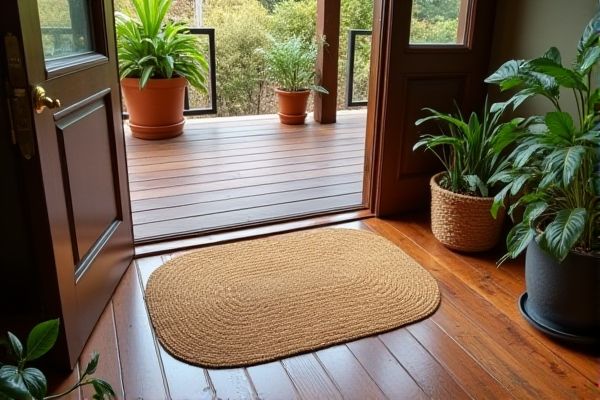
Coir mats, made from natural coconut fibers, offer excellent water absorption and a rustic aesthetic ideal for porches, while rubber mats provide superior durability, slip resistance, and easy maintenance. Discover which option best suits your porch needs by exploring the key differences and benefits in this article.
Table of Comparison
| Feature | Coir Mat | Rubber Mat |
|---|---|---|
| Material | Natural coconut fiber | Synthetic rubber |
| Durability | Moderate; degrades with moisture | High; weather-resistant |
| Water Resistance | Absorbent; not water-resistant | Waterproof |
| Traction | Good; coarse surface | Excellent; non-slip |
| Eco-Friendliness | Biodegradable, sustainable | Non-biodegradable |
| Maintenance | Requires regular cleaning | Easy to clean with water |
| Ideal Use | Dry, covered porches | Wet or high-traffic porches |
| Price Range | Affordable | Moderate to high |
Introduction: Coir Mat vs Rubber Mat for Porches
Coir mats, made from natural coconut fibers, offer excellent durability and water absorption, making them ideal for outdoor porches prone to moisture and dirt. Rubber mats provide superior slip resistance and weather resilience, ensuring safety and longevity under varying climatic conditions. Both materials serve distinct functional benefits, with coir mats enhancing eco-friendliness and aesthetic appeal, while rubber mats prioritize safety and ease of maintenance.
Material Composition and Sustainability
Coir mats are made from natural coconut fibers, offering biodegradable and eco-friendly properties ideal for sustainable porch use. Rubber mats consist of synthetic or recycled rubber, providing durability and water resistance but with less environmental biodegradability. Choosing coir mats supports renewable resource use and compostability, while rubber mats offer longevity and recycling potential in sustainable material management.
Durability and Lifespan
Coir mats offer natural durability due to their dense coconut fiber construction, typically lasting 3 to 5 years with moderate foot traffic. Rubber mats provide superior longevity and resilience, often exceeding 7 years, as they resist moisture, mold, and harsh weather conditions better than coir. Choosing between coir and rubber mats depends on desired aesthetic and environmental factors, with rubber mats being preferable for long-term durability on porches.
Weather Resistance and Outdoor Suitability
Coir mats exhibit strong weather resistance due to their natural coconut fiber composition, allowing them to withstand moisture and moderate sun exposure while maintaining durability. Rubber mats offer superior outdoor suitability with excellent resistance to extreme weather conditions, including heavy rain, UV rays, and temperature fluctuations, ensuring long-lasting performance. While coir mats provide a more eco-friendly option with adequate weather resistance, rubber mats deliver enhanced durability and low maintenance for porch areas exposed to harsh elements.
Cleaning and Maintenance Requirements
Coir mats require regular shaking and occasional vacuuming to remove dirt and debris, but they may retain moisture and develop mold if not properly dried. Rubber mats are easier to clean, often needing just a simple hose-down or wipe to eliminate dirt and grime, and they resist mold and mildew better due to their non-porous surface. Choosing a rubber mat for your porch can reduce time spent on maintenance while offering durable, weather-resistant performance.
Safety and Slip-Resistance
Coir mats offer natural slip resistance due to their coarse fiber texture, making them effective at scraping dirt and moisture from shoes and reducing slip hazards. Rubber mats provide enhanced safety with superior grip and shock absorption properties, maintaining traction even when wet or icy. Your choice between coir and rubber mats should consider the environment and moisture levels to ensure maximum safety and slip resistance on your porch.
Aesthetic Appeal and Design Options
Coir mats offer a natural, rustic aesthetic with a variety of earthy tones and textured weaves that complement traditional and eco-friendly porch designs. Rubber mats provide a sleek, modern look with diverse patterns and vibrant colors that enhance contemporary or minimalist outdoor spaces. Choosing between coir and rubber mats depends on desired visual impact and thematic consistency for the porch area.
Environmental Impact and Eco-Friendliness
Coir mats, made from natural coconut fibers, are biodegradable and renewable, making them an environmentally friendly choice that reduces plastic waste and soil pollution. Rubber mats, while durable and water-resistant, are often made from synthetic or non-recyclable materials derived from petroleum, contributing to longer decomposition times and higher carbon footprints. Choosing coir mats for porches supports sustainable resource use and minimizes environmental impact through natural decomposition and reduced chemical processing.
Cost Comparison and Long-Term Value
Coir mats generally cost less initially compared to rubber mats, making them an economical choice for porch use. However, rubber mats offer greater durability and weather resistance, providing better long-term value by reducing replacement frequency. Your investment in a rubber mat will likely save money over time due to its superior lifespan and maintenance ease.
Which Mat is Best for Your Porch?
Coir mats excel in durability and natural water absorption, making them ideal for outdoor porches that experience heavy foot traffic and moisture. Rubber mats offer superior slip resistance and easy cleaning, which benefits porches exposed to wet or muddy conditions. Your best choice depends on whether you prioritize eco-friendly materials and rustic aesthetics or enhanced safety and low maintenance for your porch.
 homyna.com
homyna.com